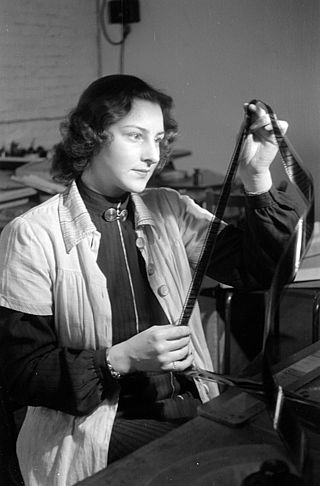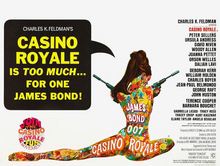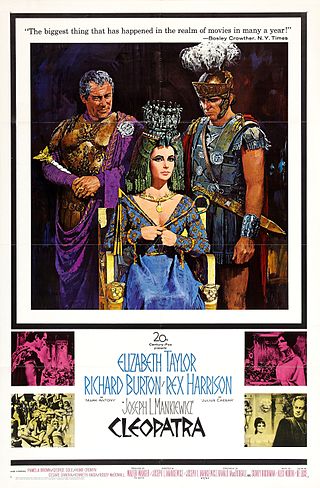In film and video, a cutaway is the interruption of a continuously filmed action by inserting a view of something else. It is usually followed by a cut back to the first shot. A cutaway scene is the interruption of a scene with the insertion of another scene, generally unrelated or only peripherally related to the original scene. The interruption is usually quick, and is usually, although not always, ended by a return to the original scene. The effect is of commentary to the original scene and creates variety.
In fiction, continuity is the consistency of the characteristics of people, plot, objects, and places seen by the audience over some period of time. It is relevant to many genres and forms of storytelling, especially if it is long-running.

Film editing is both a creative and a technical part of the post-production process of filmmaking. The term is derived from the traditional process of working with film which increasingly involves the use of digital technology. When putting together some sort of video composition, typically, you would need a collection of shots and footages that vary from one another. The act of adjusting the shots you have already taken, and turning them into something new is known as film editing.

A storyboard is a graphic organizer that consists of illustrations or images displayed in sequence for the purpose of pre-visualizing a motion picture, animation, motion graphic or interactive media sequence. The storyboarding process, in the form it is known today, was developed at Walt Disney Productions during the early 1930s, after several years of similar processes being in use at Walt Disney and other animation studios.

In a literary work, film, or other narrative, the plot is the sequence of events in which each event affects the next one through the principle of cause-and-effect. The causal events of a plot can be thought of as a series of events linked by the connector "and so". Plots can vary from the simple—such as in a traditional ballad—to forming complex interwoven structures, with each part sometimes referred to as a subplot or imbroglio.

A clapperboard, also known as a dumb slate, clapboard, film clapper, film slate, movie slate, or production slate, is a device used in filmmaking and video production to assist in synchronizing of picture and sound, and to designate and mark the various scenes and takes as they are filmed and audio-recorded. It is operated by the clapper loader. It is said to have been invented by Australian filmmaker F. W. Thring. Due to its ubiquity on film sets, the clapperboard is frequently featured in behind-the-scenes footage and films about filmmaking, and has become an enduring symbol of the film industry as a whole.

A film transition is a technique used in the post-production process of film editing and video editing by which scenes or shots are combined. Most commonly this is through a normal cut to the next shot. Most films will also include selective use of other transitions, usually to convey a tone or mood, suggest the passage of time, or separate parts of the story. These other transitions may include dissolves, L cuts, fades, match cuts, and wipes.
A cold open is a narrative technique used in television and films. It is the practice of jumping directly into a story at the beginning of the show before the title sequence or opening credits are shown. In North American television, this is often done on the theory that involving the audience in the plot as soon as possible will reduce the likelihood of their switching from a show during the opening commercial. A cold open may also be used to recap events in previous episodes or storylines that will be revisited during the current episode.
Filmmaking or film production is the process by which a motion picture is produced. Filmmaking involves a number of complex and discrete stages, beginning with an initial story, idea, or commission. Production then continues through screenwriting, casting, pre-production, shooting, sound recording, post-production, and screening the finished product before an audience, which may result in a film release and exhibition. The process is nonlinear, as the director typically shoots the script out of sequence, repeats shots as needed, and puts them together through editing later. Filmmaking occurs in a variety of economic, social, and political contexts around the world, and uses a variety of technologies and cinematic techniques to make theatrical films, episodic films for television and streaming platforms, music videos, and promotional and educational films.

Principal photography is the phase of producing a film or television show in which the bulk of shooting takes place, as distinct from the phases of pre-production and post-production.

Screenwriting or scriptwriting is the art and craft of writing scripts for mass media such as feature films, television productions or video games. It is often a freelance profession.
An act is a major division of a theatre work, including a play, film, opera, ballet, or musical theatre, consisting of one or more scenes. The term can either refer to a conscious division placed within a work by a playwright or a unit of analysis for dividing a dramatic work into sequences. The word act can also be used for major sections of other entertainment, such as variety shows, television programs, music hall performances, cabaret, and literature.

In acting, units of action, otherwise known as bits or beats, are sections that a play's action can be divided into for the purposes of dramatic exploration in rehearsal.

Ben-Hur is a 1959 American religious epic film directed by William Wyler, produced by Sam Zimbalist, and starring Charlton Heston as the title character. A remake of the 1925 silent film with a similar title, it was adapted from Lew Wallace's 1880 novel Ben-Hur: A Tale of the Christ. The screenplay is credited to Karl Tunberg, but includes contributions from Maxwell Anderson, S. N. Behrman, Gore Vidal, and Christopher Fry. The cast also features Stephen Boyd, Jack Hawkins, Haya Harareet, Hugh Griffith, Martha Scott, Cathy O'Donnell and Sam Jaffe.
In television and film, a plot point is any incident, episode, or event that "hooks" into the action and spins it around into another direction.

Casino Royale is a 1967 spy parody film originally distributed by Columbia Pictures featuring an ensemble cast. It is loosely based on the 1953 novel of the same name by Ian Fleming, the first novel to feature the character James Bond.
A scene is a dramatic part of a story, at a specific time and place, between specific characters. The term is used in both filmmaking and theatre, with some distinctions between the two.
A script supervisor is a member of a film crew who oversees the continuity of the motion picture including wardrobe, props, set dressing, hair, makeup and the actions of the actors during a scene. The notes recorded by the script supervisor during the shooting of a scene are used to help the editor cut the scene. They are also responsible for keeping track of the film production unit's daily progress. The script supervisor credit is typically in the closing credits of a motion picture. Script supervisors are a department head and play a crucial role in the shooting of a film. It is the script supervisor's job to monitor the camera shots, seeking to maintain coherence between the scenes.
Montage is a film editing technique in which a series of short shots are sequenced to condense space, time, and information. Montages enable filmmakers to communicate a large amount of information to an audience over a shorter span of time by juxtaposing different shots, compressing time through editing, or intertwining multiple storylines of a narrative.

Cleopatra is a 1963 American epic historical drama film directed by Joseph L. Mankiewicz, with a screenplay adapted by Mankiewicz, Ranald MacDougall and Sidney Buchman from the 1957 book The Life and Times of Cleopatra by Carlo Maria Franzero, and from histories by Plutarch, Suetonius, and Appian. The film stars Elizabeth Taylor in the eponymous role, along with Richard Burton, Rex Harrison, Roddy McDowall and Martin Landau. It chronicles the struggles of the young queen Cleopatra VII of Egypt to resist the imperial ambitions of Rome.










